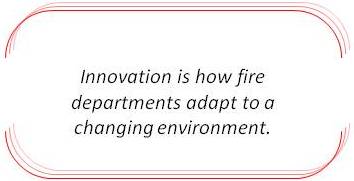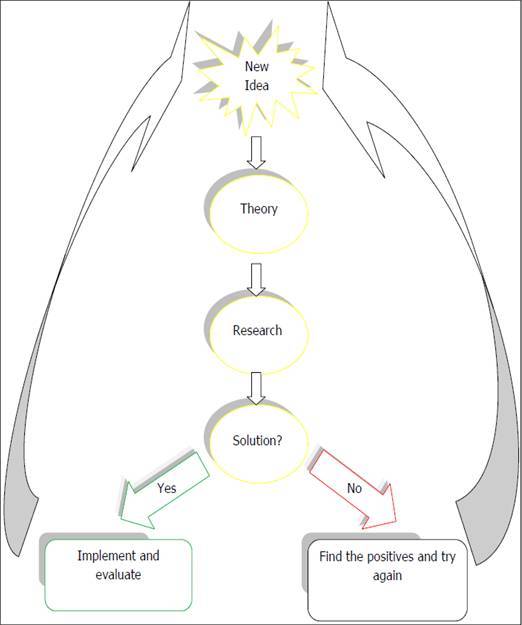By Craig Nelson and Dane Carley
Scenario: Firefighter Joe, who has two years of experience with the department, walks into the station’s kitchen one morning and says, “You know that problem we’ve had? I have an idea to fix it.” What reply would you expect to hear from anyone sitting at the kitchen table? Would at least one person say something similar to “That won’t work here,” “We already tried that,” or “Get your time in first, kid.” Although these reactions are not as common in the fire service as we like to joke about, they are still more common than is good for the fire service.
Why are new ideas important to the fire service and, more specifically, to your  department? Ideas turn into innovation, and innovation is how departments adapt to a changing environment. The changing environment may be the fuel load in a fire environment, building construction, public expectations of service, or political limitations. Regardless of the source of change, innovation helps a department adapt. Granted, adaptation can be reactive or proactive.
department? Ideas turn into innovation, and innovation is how departments adapt to a changing environment. The changing environment may be the fuel load in a fire environment, building construction, public expectations of service, or political limitations. Regardless of the source of change, innovation helps a department adapt. Granted, adaptation can be reactive or proactive.
The root of proactive innovation is the need to develop a culture that believes good is never good enough. Proactive innovation comes from being open to new ideas from a variety of sources, then testing an idea, and possibly implementing it. How do we know if an idea will work for the fire service or a department? One way is to run the idea through the “Idea Machine” to evaluate it based on its merit rather than opinion and anecdotal evidence.
The Idea Machine – a simplified illustration of an idea testing process

The next time someone brings an idea to you, make a conscious effort to: (1) stop and think about it for 30 seconds before responding and (2) find what would work instead of what would not work.
When was the last time your department looked to a fire service trade journal like Fire Engineering for a new idea? It probably was not too long ago. When was the last time your department looked to the fire laboratory at the National Institute of Standards and Technology (NIST) or Underwriter’s Laboratory (UL) for a new idea? Again, it may have been recently, since NIST and the UL have been producing such valuable research. Has your department looked to the forest service for ideas? Private industries? NASA?
The next time Firefighter Joe or anyone else in the department comes into the kitchen and says, “I have an idea,” the reaction should be, “Let’s hear it.” Then take that idea; discuss it; tweak it; and develop it into a theory that the company, shift, or department can test based on its merit. If it has merit, then it is worth researching. If the research supports the idea, try to implement it. If the research does not support the idea or the idea fails during implementation, find out why it failed and run it through the Idea Machine again.
An idea not supported by data or that does not have merit helps teach us what does and does not work. Look at it as practice; it is okay if the idea was a failure because failure is about learning. Failure makes the idea stronger because now we know what was positive about the idea, what were its weak points, and how we can tweak it, We can now run it through the Idea Machine again.
Discussion Questions
- We often joke in the fire service that years, decades, or centuries of tradition have been unimpeded by progress. AlthoughWhile there is a nugget of truth in this saying, it is not unique to the fire service, and it sells the fire service short. What has your department done to adapt to changing conditions?
- Why do people tend to react negatively to a new idea?
- How are new ideas brought forward in your department?
- What should happen when an idea cannot be used (e.g. political or financial limitations)?
Possible Discussion Topics
- The fire service as a whole has brought forward innovative ideas in many ways. A short list of recent innovations includes constantly improving personal protective equipment and self-contained breating apparatusA, compressed air foam systems, diversifying personnel, adopting incident management systems, placing an increased emphasis on education, increasing the services provided, and beginning to look at human behaviors solutions in conjunction with technological solutions.
- A new idea challenges long-held beliefs, and long-held beliefs become truths. People believed the earth was flat because they had never known any different—it was a truth to them. Likewise, new ideas challenge our beliefs. Since we have believed something for so long, it is part of us. A new idea can easily be interpreted as saying, “You have done this wrong all these years.” In that case, we take an idea as a personal challenge.
- Departments have a variety of ways to bring ideas forward. Most often, ideas theoretically float up the chain of command. However, this is sometimes short-circuited by a long or challenging hierarchy. Departments have implemented other methods to be sure every idea has a chance to be heard. These might include blogs, collaborative software, committees involving all ranks, and so on.
- Sometimes, no matter how good an idea is, there are limitations that prevent its implementation. In these cases, it is important to respond to the person who had the idea and explain the situation. It is frustrating to never hear anything back. Not responding can lead to alienation and reduced performance for the individual. This also creates an atmosphere that discourages others to come forward with ideas.
Craig Nelson (left) works for the Fargo (ND) Fire Department and works part-time at Minnesota State Community and Technical College – Moorhead as a fire instructor. He also works seasonally for the Minnesota Department of Natural Resources as a wildland firefighter in Northwest Minnesota. Previously, he was an airline pilot. He has a bachelor’s degree in business administration and a master’s degree in executive fire service leadership.
Dane Carley (right) entered the fire service in 1989 in southern California and is currently a captain for the Fargo (ND) Fire Department. Since then, he has worked in structural, wildland-urban interface, and wildland firefighting in capacities ranging from fire explorer to career captain. He has both a bachelor’s degree in fire and safety engineering technology, and a master’s degree in public safety executive leadership. Dane also serves as both an operations section chief and a planning section chief for North Dakota’s Type III Incident Management Assistance Team, which provides support to local jurisdictions overwhelmed by the magnitude of an incident.
Previous Articles
- Tailboard Talk: Is the Fire Service Highly Reliable?
- Tailboard Talk: What Is the Best Way for Firefighters to Learn?
- Tailboard Talk: Is Your Fire Department Fat, Dumb, and Happy?
- Tailboard Talk: Write More Rules or Empower Your Firefighters?
- Tailboard Talk: Should Firefighters Train More with Outside Agencies?
- Tailboard Talk: The Fire Service Does This Better Than Anyone, But Do We Recognize It?
-
Tailboard Talk: Is It Freelancing or Showing Initiative?
- Tailboard Talk: Do Firefighters Talk Too Much or Not Enough?
- Tailboard Talk: Do You Really Know What Is Happening With Your Fire Department?

